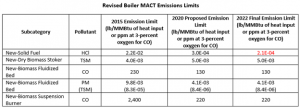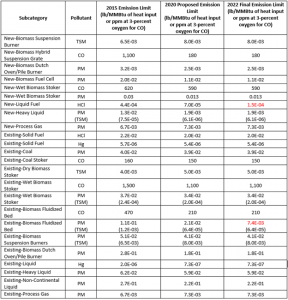U.S. EPA Finalizes Changes to Boiler MACT
Posted: July 25th, 2022
Authors: Amy M. Anna R.
The National Emission Standards for Hazardous Air Pollutants (NESHAP) for Industrial, Commercial, and Institutional Boilers and Process Heaters, which implements Maximum Achievable Control Technology (MACT) standards and is therefore also known as Boiler MACT, were promulgated on March 21, 2011, and amended on January 31, 2013, and November 20, 2015. Existing boilers and process heaters have been in compliance with the rule for several years now, and even new units (those for which construction commenced after June 4, 2010) feel like existing units at this point.
On July 21, 2022, the United States Environmental Protection Agency (U.S. EPA) signed a final rule that results in changes to the Boiler MACT in response to multiple court decisions. With the final rule, U.S. EPA is re-affirming two conclusions regarding carbon monoxide (CO) (that CO is a good surrogate for non-dioxin organic HAP and that a 130 ppm CO concentration threshold represents MACT for organic HAP for several subcategories), is revising many of the emissions limits, and is making other minor changes. Of the 34 revised emissions limits, 28 of the limits are more stringent than those in the previous version of the rule and six of the limits are less stringent. The technical corrections fix errors, improve clarity, and incorporate procedures into the rule for using carbon dioxide (CO2) instead of oxygen (O2) as a diluent.
What Emissions Limits Changed?
Table 1 of the preamble lists the limits that U.S. EPA is proposing to change based on their re-analysis of the dataset used in the 2013 rulemaking. For existing boilers, the changes to note are small reductions in the hydrogen chloride (HCl) and mercury limits for solid-fuel units, a reduction of the mercury limit for oil-fired units, and several changes to biomass-fired unit CO and particulate matter (PM) limits. The final revised PM limit for biomass-fired fluidized bed units is significantly more stringent. For new units, several proposed limits are also significantly more stringent than current limits, such as the HCl limits for new solid-fuel units and new oil-fired units. The table below lists the revised limits, three of which (highlighted in red) are more stringent than the 2020 proposal.
What Happens Now?
After the rule is published in the Federal Register, facilities will have three years to comply with the revised limits (this includes boilers and process heaters currently classified as new units). Facilities subject to the Boiler MACT should review the emissions limits and determine if compliance strategies may need to be adjusted. Is a new air emissions control strategy or a new fuel mix required? Should stack testing be used for compliance rather than fuel analysis?
Although we’ve seen several iterations of a Boiler MACT in the past two decades, even this change is not the last. U.S. EPA is also obligated to conduct a risk and technology review of the rule, and that review could lead to even more stringent requirements. In addition, there is always the chance that a petition for reconsideration could cause U.S. EPA to adjust the changes they finalized. ALL4 staff are keeping on top of these developments and can help you determine if you need to develop a strategy to comply with the revised emissions limits. Reach out to Amy Marshall or Anna Richardson for more information.



